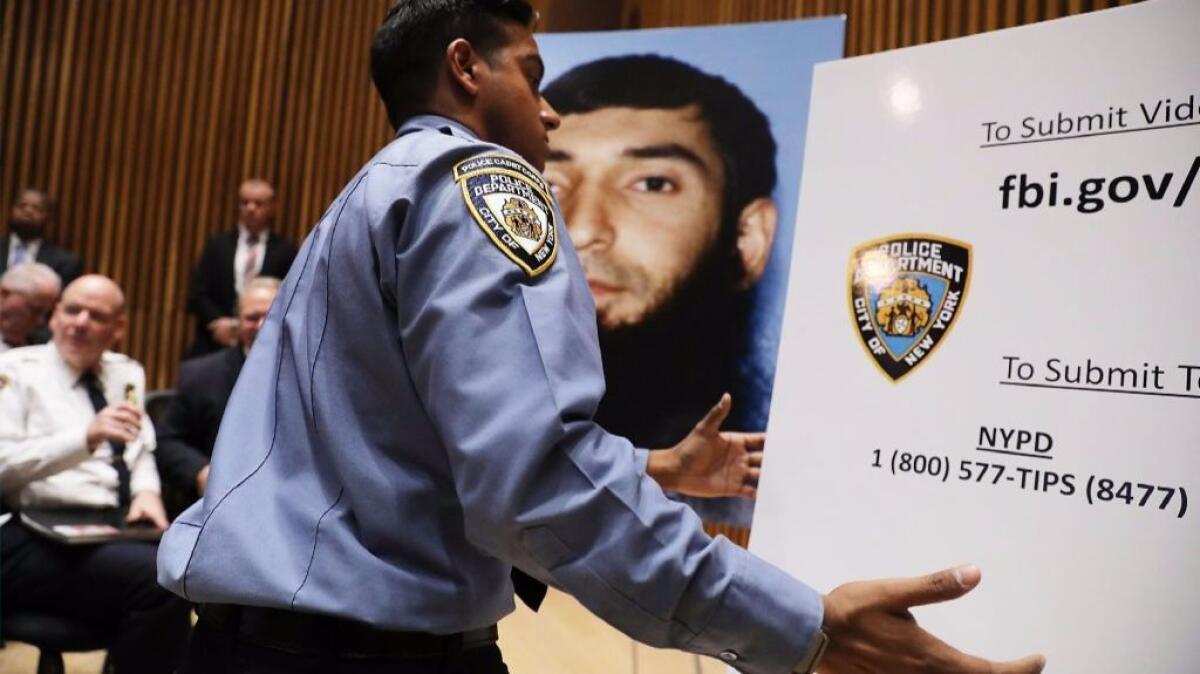Q&A: Here’s the visa program New York terrorism suspect Sayfullo Saipov used to get into the country

It’s an immigration program that’s been around for more than two decades, offering a limited number of visas to people from across the world.
Well known abroad, it has received little public attention in the U.S. — until now.
On Wednesday — a day after a rented pickup barreled down a crowded bicycle path in Manhattan, killing eight people — federal officials said the suspect in the attack, 29-year-old
That kicked off a political debate.
“He came in through the diversity program … we’re going to stop that,”
Here is some background on the program best known as the “visa lottery.”
When was it started?
The program dates to the Immigration Act of 1990. It was tucked inside the legislation largely in response to lobbying by Irish and Italian American groups who hoped to help distant relatives gain U.S. residency. Passed by lawmakers from both parties and signed by Republican President George H.W. Bush, the immigration law put the diversity visa program into effect in 1995.
What’s its goal?
The mission, according to the U.S. State Department, is simple: grant permanent resident visas — better known as green cards — to people in countries with low rates of immigration to the United States.
Jonathan Turley, a law professor at George Washington University, said the program was “a recognition that some areas of the world have historically been given few opportunities for entry.”
“It was never a lottery in the sense of buying a winning ticket to waltz into the United States without little vetting or review,” he said.
How does it work?
Each year, millions of people from around the world apply for the visa program during a 30-day window, often in the fall, but occasionally during other times of the year.
Applicants must have a high school education or its equivalent. The first round of the selection process is a lottery. Those lucky enough to make the cut are then put through the standard vetting process for any foreigner seeking U.S. residency.
Ultimately, about 50,000 applicants are successful each year. They are distributed among six geographic regions — Africa, Asia, Europe, Latin America, North America and the South Pacific island nations known collectively as Oceania — and within a given region no single country may receive more than 7% of the visas.
How many people have been admitted through the program?
Between 2007 and 2016, nearly 473,000 people were granted a diversity visa. The largest share have gone to Africans, who accounted for 43% of those awarded last year, compared with 32% that went to Europeans, 19% to Asians, 3% to Latin Americans and less than 1% to people from Oceania.
In 2010, the year Saipov received a visa, nearly 3,300 people from Uzbekistan were granted diversity visas, according to the State Department.
Last year, about 46,000 people in total were awarded the visas, with 2,300 arriving from Uzbekistan.
Have terrorists used the program in the past?
Yes.
Hesham Mohamed Hadayet and his wife received diversity visas in 1997. Five years later, he killed two people at Los Angeles International Airport.
Even so, Joseph K. Young, a professor of law and criminology at American University, said research on terrorism suggested that immigrants were less of a threat than people born in the United States.
“Single events like this are tragic, but this does not mean all immigrants in this program or any other are more dangerous than homegrown threats,” Young said.
What is the status of the program?
It remains in place.
In 2013, a bipartisan group of senators known as the “Gang of Eight” crafted a comprehensive immigration bill that included a provision to scale back the diversity visa program in favor of merit-based system that centered on education and job skills.
The bill passed the
What are lawmakers proposing to do with the program?
On Wednesday, Trump criticized Democrat Charles E. Schumer, the Senate minority leader, for his support of the diversity program in the early 1990s, and advocated for a system along the lines that had been put before lawmakers in 2013 .
“The terrorist came into our country through what is called the ‘Diversity Visa Lottery Program,’ a Chuck Schumer beauty,” Trump tweeted. “I want merit-based.”
Schumer, who was among the Gang of Eight, pushed back against Trump’s accusations.
“I guess it’s not too soon to politicize a tragedy,” Schumer said.
Sen. Jeff Flake, a Republican from Arizona who also worked on the comprehensive immigration bill, came to Schumer’s defense.
“Actually, the Gang of 8, including @SenSchumer, did away with the Diversity Visa Program as part of broader reforms. I know, I was there,” he said on Twitter.
Sign up for Essential California
The most important California stories and recommendations in your inbox every morning.
You may occasionally receive promotional content from the Los Angeles Times.








